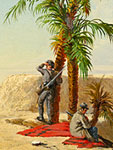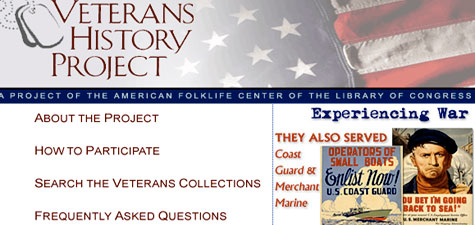Local War Stories: Francis Murphy
World War II U.S. Navy veteran Francis Murphy talks about his experiences during the war, in the Atlantic theater.
Audio and video options are available.
World War II U.S. Navy veteran Francis Murphy talks about his experiences during the war, in the Atlantic theater.
Audio and video options are available.
World War II U.S. Navy veteran Gerald Halderman talks about his experiences during the war, in the Pacific theatre.
The audio of this clip is available as a downloadable MP3 file.
World War II welder and wife of a veteran Margaret Spalluzzi talks about working as a welder during the war, life as a civilian during the war, and communicating with her husband overseas.
The audio portion of this oral history is available independently as a MP3 file.
World War II veteran Theodore Akimoto shares his personal memories of the war.
The audio from this clip is available independently as a MP3 file.
World War II veteran Susumu Ito talks about his memories of serving in the all-Japanese-American 442nd Regimental Combat Team during the war and the internment of his parents in an American internment camp. The presentation includes film footage, images, and subtitles.
Vietnam War veteran Robert Vinson talks about his experiences in Vietnam and returning home on leave during the war and after his service in the war, including his struggle with PTSD and use of massage and movement therapy.
World War II veteran Mary Ginnerty shares her personal memories of the war.
The audio of this oral history is available independently as a MP3 file.

This Museum of the Confederacy website offers access to 31 paintings created during the Civil War by a Confederate soldier.
The simplest way to navigate the site is to click the "next" arrows located at the bottom right of each page. This will flip to the next "page," causing the website to read like a book. The exhibit is not overly long or text heavy, so this is a pleasant way to approach the material. The first page introduces you to Conrad Chapman and his father John, U.S.-born artists who largely lived in Europe. Conrad traveled to the U.S. in 1861 to join the Confederate Army. As a soldier he was ordered to sketch the defenses of Charleston, SC. These sketches became the basis for the 31 oil paintings which constitute the majority of the exhibit. Chapman and his father both painted scenes based on Conrad's sketches for 25 years.
Additional pages include a map of Charleston's defenses; a small amount of information on General P. G. T. Beauregard, Chapman's commanding officer; and images of the paintings accompanied by commentary by Chapman himself.
Note that prior to viewing the paintings, the website will have a page suggesting the purchase of prints. As a result, it may be wise to access the page and select images prior to your classes rather than allow students to navigate on their own.
Once called Armistice Day, Veterans Day has evolved into a day of recognition for all U.S. military veterans, not only those who fought in World War I. This year, the holiday falls on a Friday (November 11), only a week away. How do you celebrate Veterans Day? How do your students celebrate? Do they have veterans in their families? Do they know the history of the holiday? Each student's awareness of Veterans Day and his or her understanding of what it means and how it should be observed will be unique—and ripe for discussion and exploration.

This year, Teachinghistory.org has gathered all of our resources on Veterans Day in one place: our Veterans Day spotlight page. On the page, you can find materials for learning about the history of Veterans Day and the branches of the U.S. military and about the experiences of individual soldiers at war—from the American Revolution to the present day. Get ideas for teaching with monuments and memorials and with oral history, or watch a historian analyze civil war letters. Take quizzes on the 54th Massachusetts (the African American Civil War regiment featured in the film Glory), Operation Desert Storm, and other topics related to veterans and war. (Remember that our previous spotlight pages, on 9/11, Constitution Day, and Columbus Day are still available—and don't forget to visit our new Thanksgiving spotlight.)
If you need more resources, the Library of Congress's Veterans History Project preserves the experiences of thousands of veterans through oral history. The memories of more than 3,000 veterans are featured online, including interview transcripts and audio and video recordings (go to "Search the Veterans Collection" and choose "yes" for "Transcript?" and "Digitized Collection?"). A Library of Congress blog entry gives a quick overview of the Project and ways to use it in the classroom.
At HISTORY.com, you or your students can learn about the Take a Veteran to School program, tweet in honor of veterans (use hashtag #thankavet), or read guidelines for donating photos to the Vietnam Veterans Memorial Fund. The 21-min. online video "The Story of Veterans Day" gives a quick, accessible introduction to the holiday and its history.
For recent materials on Veterans Day, check out the official White House website. Here, you can read Obama's Veterans Day proclamations and find photos and articles on the celebration of Veterans Day in recent years. The Department of Veterans Affairs lists regional Veterans Day observances—and also features a free downloadable teacher resource guide.

An oral history project with veterans is a great way to involve students in family, community, national, and global history. And it's a useful methodology for teaching how to work with historical evidence.
Far more than simple question and answer sessions, oral history is actually a systematized, disciplined effort to record, preserve, and interpret memories of historical significance. It helps students find out about the past, and encourages them to ask critical questions about who tells the story and how it's told. Good oral history projects require research into primary and secondary sources; they exercise planning and interpretive skills; and they ask students to unite mega and micro narratives. Kindergarten pupils can do it, and so can AP history students with learner-appropriate requirements for exercising historical thinking skills—it's an activity adaptable across the curriculum and across grade levels.
The Library of Congress helps bring oral history into the curriculum through the Veterans History Project (VHP), a massive and accessible example of the power of personal narrative. Created in 2000, the VHP collects and preserves the remembrances of American war veterans and civilian workers who supported them from World War I through today's Afghanistan and Iraq conflicts. These collections of firsthand accounts are archived in the American Folklife Center at the Library of Congress.
Not all collections are digitized, but photos, documents, artifacts, and video or audio-recorded interviews (with transcripts) accompany each individual story that is online. Listen to a 50-minute interview and view 39 photographs from Corporal Frank Aceves, a Vietnam War veteran; visit the section Women at War to hear from the first woman Brigadier General in the U.S. Air Force; or check out stories from Buffalo Soldiers, members of only a handful of African American units allowed to serve in combat during World War II.
The Veterans History Project encourages high school students to consider adding to their archives, and they provide specific, detailed information about how to do so from planning through submission.
If you're thinking about developing materials in your own classroom to submit to the Library of Congress Veterans History Project, follow the Wiki Know-How Guide from Eastern Lebanon County High School. This wiki includes step-by-step directions and student work pages as well as examples of students' final projects.
In 2009, the History Channel, together with the Veterans History Project hosted a National Teach-in on Veterans History. The archived hour-long broadcast from the Library of Congress is available online.
The History Channel encourages students and teachers to engage with veterans through Take a Veteran to School Day and the project comes complete with Teacher Resources, from setting up the project to asking questions to sending follow-up thank you notes.
Take a Veteran to School Day is for all grade levels. The online video resources about Veterans Day are most useful from upper elementary through high school, and their materials also include PDFs of primary sources, how-to-do oral histories, and Spanish-language guides.
Making Sense of Oral History in the Clearinghouse under Best Practices is an excellent guide with examples for teachers and for advanced history students about how to create and interpret oral history interviews.